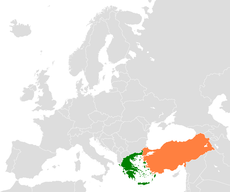Greece–Turkey border
This article needs additional citations for verification. (July 2019) |
| Greece–Turkey border Σύνορα Ελλάδας–Τουρκίας Türkiye–Yunanistan sınırı | |
|---|---|
 | |
| Characteristics | |
| Entities | |
| Length | 212 km (132 mi)[1] |

The Greece–Turkey border (Greek: Σύνορα Ελλάδας–Τουρκίας, romanized: Sýnora Elládas–Tourkías, Turkish: Türkiye–Yunanistan sınırı) is around 200 kilometres (120 mi) long, and separates Western Thrace in Greece from East Thrace in Turkey.
Course
It mostly follows the river Evros. At some places the border does not follow the main course of the river, mainly because the river has been straightened.
Barrier
It is the external border of the
Aegean dispute
Between the two countries, there are political disputes over several aspects of political control over the
History

After the
Following the
The Greek-Turkish border, as defined by Lausanne, is effectively a reaffirmation of the
European migrant crisis
Because the refugees entering Europe in 2015 were predominantly from the
After the
At the start of the 2020 Greek–Turkish border crisis in late February 2020, migrants started to gather at the Greek-Turkish land border after Turkish president Recep Tayyip Erdoğan announced that he would no longer "block" refugees and migrants' "access to the border", and opened the border with Greece.[11][12] Turkey's government was also accused of pushing refugees into Europe for political and monetary gain.[13]
During March 2020, the migrants repeatedly tried to cross the border fence but they were blocked by Greek army, police, and small detachments of policemen from Austria, Cyprus, Czech Republic, and Poland, who defended the fence and resisted the migrants using tear gas. Among those who illegally attempted to cross were individuals from Africa, Iran, Afghanistan, and Syria. Greece responded by refusing to accept asylum applications for a month.[14][15] As migrants tried to breach the border fence using tools, they also set fires, threw stones, and
On 2 March, Muhammad al-Arab, a Syrian asylum seeker was shot dead on Turkish soil from 15–135 metres (49–443 ft) away. According to an analysis by Forensic Architecture, the victim was shot by Greek soldiers standing at the border.[18] On 4 March, Turkish authorities reported that the Greek border guard used live rounds and injured asylum seekers. Forensic Architecture reviewed the evidence and found that one Pakistani, Muhammad Gulzar, was killed and seven were wounded, and determined that it was "highly probable" that the live rounds came from the Greek side of the border.[19] According to an article by Der Spiegel, it’s "quite possible" that Gulzar was shot accidentally, by a ricochet.[20] The shooting of Gulzar has been dismissed by Greek government spokesmen, as "fake news" spread by the Turkish authorities.[21] There is still no commonly accepted account of what happened on both incidents.[18][19]
By 11 March 2020, 348 people who illegally crossed the borders had been arrested and 44,353 cases of unlawful entry had been prevented.[citation needed]
Crossings
There are three crossings along the entire border, two for vehicular traffic and one for vehicular and rail traffic. The busiest of three, İpsala, is among the busiest border checkpoints in the world.
| Province | Province | Opened | Route in Turkey | Route in Greece | Status | ||
|---|---|---|---|---|---|---|---|
| Pazarkule | Edirne | Kastanies | Evros | 20 April 1952 | Open | ||
| İpsala | Edirne | Kipoi | Evros | 10 July 1961 | Open | ||
| Uzunköprü | Edirne | Pythio | Evros | 4 September 1953 | Open |
See also
References
- ^ "Türkiyenin Komşuları ve Coğrafi Sınırları". 14 February 2016. Archived from the original on 14 February 2016.
- The Huffington Post. Published on 09/24/2015.
- ^ Egypt and Greece sign agreement on exclusive economic zone | Reuters. www.reuters.com. Retrieved 29 August 2020.
- ^ "EU urges Turkey to 'deescalate' energy dispute with Greece". Associated Press. 14 August 2020.
- ^ "Turkey threatens Greece over disputed Mediterranean territorial claims". Deutsche Welle. 5 September 2020.
- ^ Ledwith, Gabriela Baczynska, Sara (2016-04-04). "How Europe built fences to keep people out". Reuters. Retrieved 2021-08-09.
{{cite news}}: CS1 maint: multiple names: authors list (link) - ^ "Migrant 'chaos' on Greek islands – UN refugee agency". BBC News. 7 August 2015. Retrieved 28 August 2015.
- ^ Pop, Valentina (7 August 2015). "Greek Government Holds Emergency Meeting Over Soaring Migrant Arrivals". The Wall Street Journal. Retrieved 19 August 2015.
- ^ Tim Arango (7 September 2015). "A New Wave of Migrants Flees Iraq, Yearning for Europe". The New York Times. Retrieved 7 September 2015.
- ^ "Aegean islands alarm as refugee numbers rise after Turkey coup attempt". The Guardian.
- ^ a b Aris Roussinos (3 April 2020). "What the Hell Is Happening With Migrants in Greece?".
- ^ Anthee Carassava (March 26, 2020). "Migration to Greece Drops Dramatically, but EU Seeks Greater Refugee Coronavirus Protection". Voice of America.
- ^ Seth J. Frantzman (15 March 2020). "Turkey cynically pushes migrants toward coronavirus-hit Europe". Jerusalem Post.
- ^ "'Are we in Greece?': Migrants seize their chance in Europe quest". news.yahoo.com. Retrieved 2020-03-03.
- ^ "Greece blocks thousands of migrants trying to enter from Turkey". France 24. 2020-03-01. Retrieved 2020-03-03.
- ^ thraki nea (7 March 2020). "Οι Τουρκοι προσπαθουν να ριξουν το φραχτη" [The Turks trying to pul down the fence].
- ISSN 0015-7120. Retrieved 24 December 2020.
- ^ a b "The Killing of Muhammad al-Arab". Forensic Architecture. Retrieved 5 October 2021.
- ^ a b "The Killing of Muhammad Gulzar". Forensic Architecture. Retrieved 5 October 2021.
- ISSN 2195-1349. Retrieved 2021-10-06.
- ^ Petsas, Stelios (8 May 2020). "Statement by the Deputy Minister to the Prime Minister and Government Spokesman Stelios Petsas". General Secretariat for Media and Communication (in Greek and English). Retrieved 2021-10-06.
